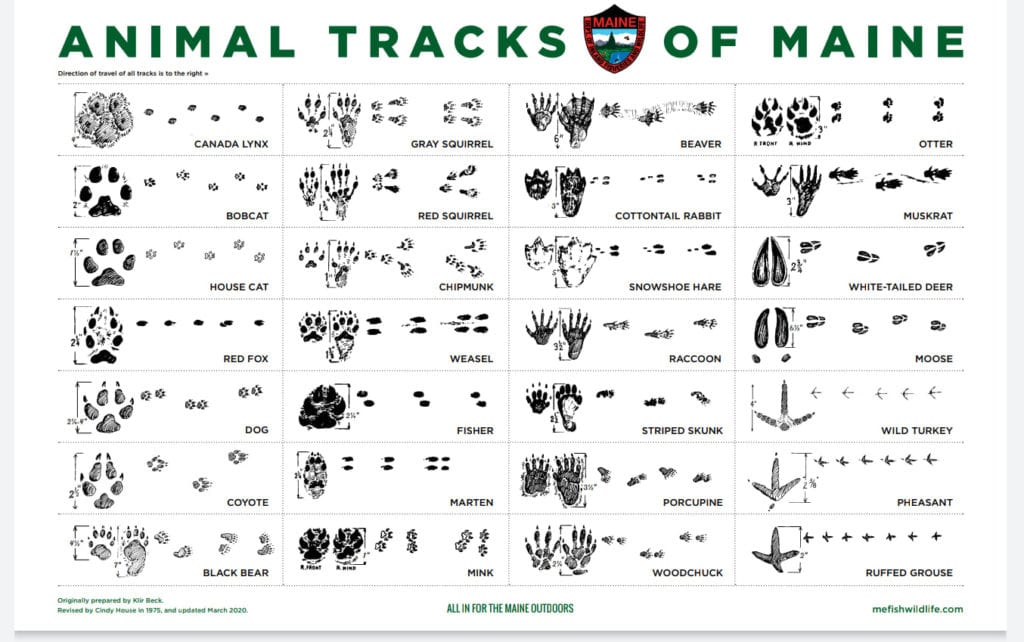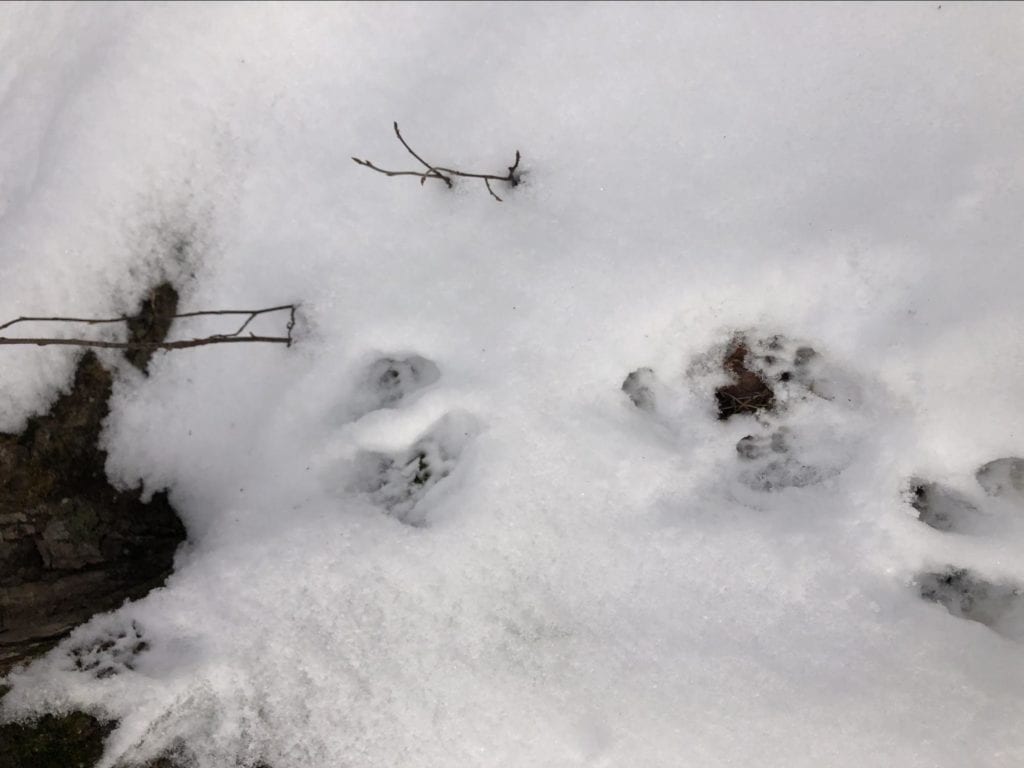
What mammals and other wildlife are active this time of year near your home? What are they up to? Where might you find them or how might you know they’ve been there?
Spring is a great time of year to start looking down at the tracks our wildlife neighbors leave behind! Since tracks can look very different depending on the substrate (type of ground covering such as snow, gravel, sand, mud, leaves), it’s helpful to learn tracking on all kinds of surfaces.
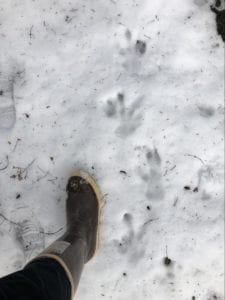
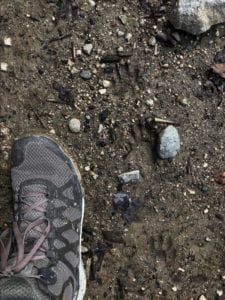
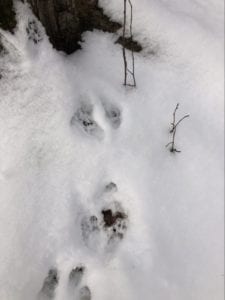
Why is there a shoe in these pictures?
Size is an important clue about who left a mystery track. Without a ruler in the field, it can be hard to show or document how large or small a track is. Tools we often have on us like our shoes, hands, hats, or water bottles can be used to show scale . . . just be careful not to step on or crush the track!



Don’t forget all the other signs of wildlife we can keep an eye out for: feathers, scat, evidence of animals building homes or nests. All of these tell you who might have been there!
Reading
Activity: Animal Track Stories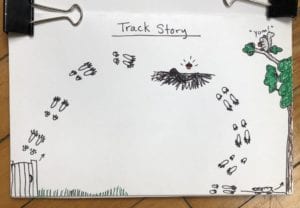
While this activity could be done entirely from your imagination, stepping out into your yard or an outdoor space–urban or rural–can provide so many ideas! We’re going to look to nature to tell us what’s been happening and then figure out a way to tell that story through a picture.
Begin by looking or listening for one of the following:
- An animal–preferably a wild one, but pets could work. Don’t forget to check for birds, too!
- Evidence of an animal–pieces of fur, signs of eating (chewed-up acorns), digging marks in the soil, scat, feathers, etc.
- Tracks or prints –check any exposed soil, sand, or mud!
Use the Maine Dept. of Inland Fisheries and Wildlife’s Animal Tracks of Maine Poster to help identify your track (or any other track guides you’ve used before or have at home!) This version of that poster also features tips and information about animal track patterns that will help you hone your tracking skills.
After exploring and making some guesses about what that animal was or what it may have been doing, start making up a story in your mind or by talking with someone. A simple but effective example could be: A squirrel ran into my yard, dug up an acorn, and then ran up a tree on the other side of the yard to eat. You could get creative and include other animals in your story, but try to stick to Maine species.
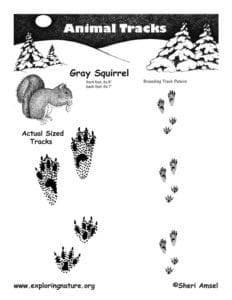 Next, grab a piece of paper or your nature journal and something to write or draw with. You could use pencil, pen, markers, crayons–whatever you like! Using the Maine Animal Tracks Poster or another guide, draw or paint a small version of the tracks you want to show. Start to draw your story:
Next, grab a piece of paper or your nature journal and something to write or draw with. You could use pencil, pen, markers, crayons–whatever you like! Using the Maine Animal Tracks Poster or another guide, draw or paint a small version of the tracks you want to show. Start to draw your story:
- How can you show what the animal did?
- How can you show where it went?
- What simple markers or symbols can you use to show the setting?
If you can, try giving your completed story to someone else and see if they can “read” it!
More Wildlife Tracking Resources:
- Naturally Curious with Mary Holland – This is an amazing blog by naturalist Mary Holland (author of an equally amazing natural history guide) that introduces the reader to many of the tracks, signs, and evidence that New England wildlife leave behind. Mary posts timely facts and information about what different animals are up, shares interesting finds, and even offers regular mystery posts for folks to make guesses about!
- Keeping Track’s Conservation and Tracking Resources – There are so many resources on this list compiled by the Vermont wildlife conservation organization, Keeping Track, to explore!
- iNaturalist.org – A web site and community of naturalists for reporting observations of plant or animal species around the world. Special projects can be designed for any specific location such as a yard or local natural area.
Our educators, scientists, advocates, and naturalists are committed to keeping you connected to the natural world as we deal with the coronavirus situation together. Check in every weekday on our Connections page for family activities, parent/teacher tips, backyard birding, nature exploration at our sanctuaries, and more.
Next Generation Science Standards
“Crosscutting Concepts” for all Elementary Grades in this module:
- Patterns
- Scale, Proportion, and Quantity
- Structure and Function
K Performance Expectations:
- Use observations to describe patterns of what plants and animals (including humans) need to survive. K-LS1-1
- Construct an argument supported by evidence for how plants and animals (including humans) can change the environment to meet their needs. K-ESS2-2
2nd Grade Performance Expectations:
- Make observations of plants and animals to compare the diversity of life in different habitats. 2-LS4-1
3rd Grade Performance Expectations:
- Construct an argument that some animals form groups that help members survive. 3-LS2-1
- Construct an argument with evidence that in a particular habitat some organisms can survive well, some survive less well, and some cannot survive at all. 3-LS4-3
- Use evidence to construct an explanation for how the variations in characteristics among individuals of the same species may provide advantages in surviving, finding mates, and reproducing. 3-LS4-2
4th Grade Performance Expectations:
- Use a model to describe that animals receive different types of information through their senses, process the information in their brain, and respond to the information in different ways. 4-LS1-2
NGSS Lead States. (2013). Next Generation Science Standards: For States, By States. Retrieved from http://www.nextgenscience.org/

